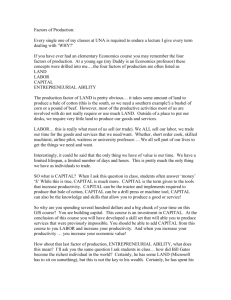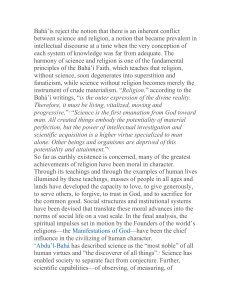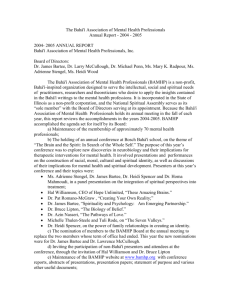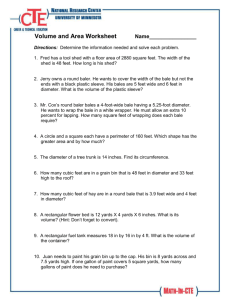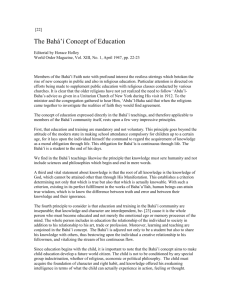Straightening Bale Ties Plans for Saving and Agricultural Experiment Station
advertisement
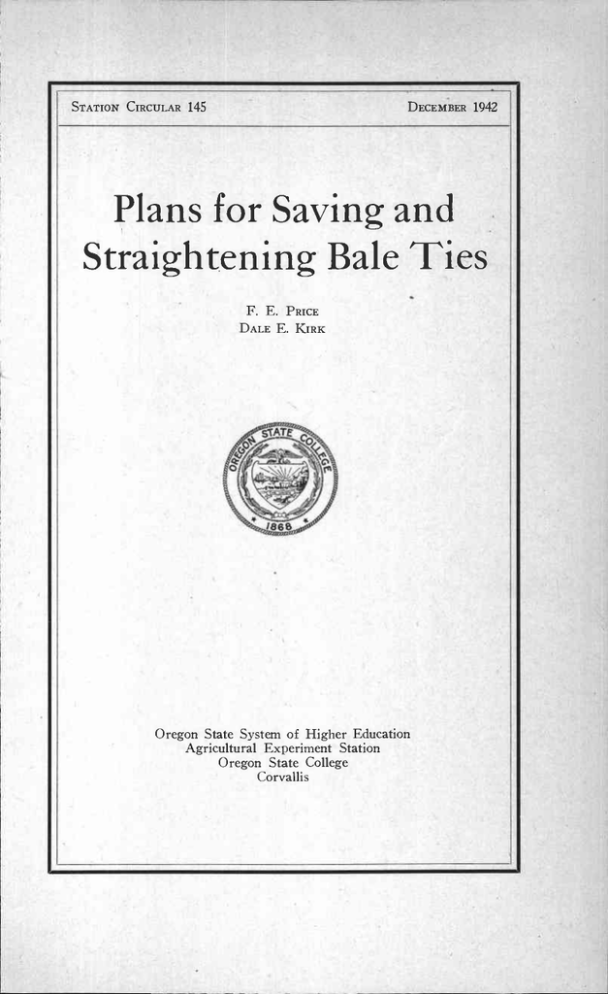
STATION CIRCULAR 145 DECEMBER 1942 Plans for Saving and Straightening Bale Ties F. E. PRICE DALE E. KIRK Oregon State System of Higher Education Agricultural Experiment Station Oregon State College Corvallis n operation. One person places th the short lever, while the o moves the lever sufficiently to ?ote the two troughs for ho eye over the holder and places the plain end of the wire tile necessary straightened and fin. v.. Plans for Saving and Straightening Bale Ties By F. E. PRICE and DALE E. KIRK, Agricultural Engineering Department bale tie straightener described in this circular was developed by the THE Agricultural Engineering Department of Oregon State College in response to numerous requests from farmers for a home-made device to straighten used bale ties. Farmers have indicated that with the aid of such a device many standard sized bale ties can be used two seasons, thus supplementing the reduced supply of new bale ties available because of the war emergency. There is some question in the minds of farmers and others regarding the practicability of using for more than 1 year the light weight bale ties that are being manufactured during the war period, because of their limited strength. The bale tie straightener serves to test the strength of the used wire, however, as well as straighten it. The wires that are not strong enough for use another season usually break in the straightening process. The demand for the bale tie straightener was increased recently when the chairman of the Oregon Agricultural War Board released the following statement to all County Agricultural War Boards under date of October 20, 1942: "While bale tie production this year was 50% greater than in normal years, reports indicate shortages existed in many areas. Next year, according to all present indications, only a fraction of a normal year's bale tie supply will be produced." It has been found that if used baling wire is pulled straight with sufficient tension to stretch the wire slightly, it will remain practically straight. The Oregon bale tie straightener consists of an eye holder for the eye end of the wire and a gripper and stretcher for the plain end of the wire. These are mounted on a work bench, or a specially constructed saw horse, and the wire is stretched sufficiently between them to remain straight. Pointers in removing ties from bales Bale ties must be kept at their original length or nearly so when they are removed from the bale if they are to be of any value as a bale tie again. One of the following methods of opening bales for the recovery of bale ties should be followed: 1)BEST METHOD: Untie or unhook the bale tie. Cut the wire near the tie but at the opposite end from the original eye, leaving the wire as long as possible. Be careful not to drop a small piece of wire that might get to the feed 2) SECOND CHOICE: manger with the hay and puncture an animal's stomach. After removal from the bale, the tie should be partly straightened by hand to remove the sharpness of the four bends it will have. Then it should be laid in a trough or hung over two or more pegs placed at least 1 foot apart. The tendency for it to tangle can be lessened by exercising a little more care in straightening out the four bends and by placing only small quantities in one trough or over one set of pegs before the ties are tied into bundles to be straightened later. In climates where the wire is likely to rust after removal V., SCALE 0 I" 2 3" 4" 5" 6" /4" WASHER HELD IN PLACE BY SHINGLE NAILS I/2PLYOR 2 LAYERS OF /4" PLY END OF 5/16" BOLT END OF BALE EYE HOLDER 3/B" X 6" MACHINE BOL.T 2X4 BASE7 5/16X Z-I/2 MACHINE BOLT HEAD SET IN 2 X 4 HANDLE SAW GROOVE TO RECESS GRIPPER SOLT 3/8 X 6 MACHINE BOLT 3f5X6' MACHINE B OLT 254 BASE 4 SECTION VIEW GRIPPER AND STRETCHER 0 4"HEAVY DUTY STRAP HINGES \ .y SHAPEO HOTCH '7 4 SECTION OF LEATHER STRAP SECTION OF OLD FILE SET IN AND 0 HELD IN PLACE BY SHINGLE NAILS 0 COOPERATIVE EXTENSION WORK IN AGRICULTURE 8 HOME ECONOMICS OREGON STATE COLLEGE CORVALLIS, OREGON PLANS BY AGRI. ENGINEERING EXP. STATION DALE E.KIRK F.E.PRICE BALE TIE STRAIGHTENER PLAN NO, 8.3i II I 42 SI4E(T I OP 6 AGRICULTURAL EXPERIMENT STATION CIRCULAR 145 from the bale, the bundles should be protected by a film of oil. A common hand spray gun filled with crankcase oil well thinned with gasoline or diesel oil may be used to apply this oil film. Figure 2. Close-up view of the stretcher end of the bale tie straightener showing: (1) the gripper and stretcher, (2) operator about to cut the wire close, to the stretcher. Construction of a bale tie straightener The essential parts of a simple, inexpensive bale tie straightener can be constructed from the following materials: SAVING AND STRAIGHTENING BALE TIES 6 ft. length of 2 x 4 1 sq. ft. of " ply or 2 sq. ft. of " ply x 6" bolts with nuts 1-5/16" x 2" bolt with nut 6-3/8" washers 2-5/16" washers 1f" washer (having actually about a 5/16" hole) 6No. 4 shingle nails 24No. 6 box nails 12No. 8 x 1" F.H. screws (will probably come with hinges indicated below) 1 pr. 4" heavy-duty strap hinges 4 in. length of 1 ' strap (hame strap or similar sound leather) 1piece of an oil file Estimated cost of foregoing materials$1.00 Although the drawing in this circular showing construction details is quite complete, the following pointers may be of some help: The gripper-stretcher pivots on the lower i-inch bolt. Therefore, do not place a screw in the hole found in the bent part of each hinge. This 1 inch of the hinge acts only as a stop to hold the small block from rotating backwards beyond its vertical position. To bend the hinges, place the hinge in a vise with 1+ inch projecting beyond the jaws. Then bend the end over with a hammer. The upper i-inch bolt in the gripper-stretcher serves only as one of the two gripping jaws. The short length of file serves as the other jaw. In order that the i-inch bolt may not act as an obstruction when the end of the bale tie is pushed between the hinges into the gripper, the bolt should be recessed at least half its diameter in a groove cut in the gripper-stretcher handle. This groove can be cut with a saw or chisel. The two upper plywood blocks are used to hold the bolt in place. Heavy duty 4-inch strap hinges must be used. Light duty hinges will pull apart with continued use. When mounting the hinges, care must be taken to get a strong attachment and also to avoid splitting the block that forms the lower half of the gripper-stretcher. Screw holes should be drilled smaller and shorter than the screws used to mount the hinges. The correct length of old file can be readily obtained by placing the file in a vise with 1 inch of it projecting beyond the jaws. A light rap on the projecting part will break it off close to the vise. The 5/16-inch bolt used as a peg to hold the eye of the bale tie must be ground or filed to a taper so that the eye will slip over easily. Note that the tapered end of the bolt is shaped to open the eye to its original size as it is forced down over the peg by the washer attached to the handle. The washer on the eye holder handle should have about a 5/16-inch hole. To locate the position of this washer, shove the handle down, forcing the tapered peg into the handle. This will form a hole locating the place to nail the washer into position. Mounting the bale tie straightener If a convenient bench or table is not available, it is suggested that the eye AGRICULTURAL EXPERIMENT STATION CIRCULAR 145 holder and gripper-stretcher assemblies be mounted on a long saw horse. This horse should have a 2 x 4 about 12 feet long laid flat for the ridge and should stand about 32 inches to 40 inches high. The gripper-stretcher should be nailed or bolted securely to one end of the saw horse. The eye holder should be bolted to the saw horse about 9 feet from the gripper-stretcher. This distance can be determined better by actually laying it out with a bale tie extended between the two assemblies. Since it may be necessary to straighten bale ties of different lengths, provision should be made to vary the distance between the eye holder and the gripper-stretcher. This can be done by having several holes in the ridge of the saw horse 6 inches apart through which the eye holder can be bolted as needed. One bolt is sufficient to hold each of the devices on the saw horse. Although uniformity in the length of the bale ties must be maintained within each bundle or groups of bundles of ties, most balers or bale presses can be operated satisfactorily to take different lengths of ties as long as the changes are not too frequent. Two troughs, each about 1 foot wide and 1 foot deep and 10 feet long, should be mounted one on each side of the saw horse. These are handy for holding the unstraightened and straightened ties. Operation The stretching operation is more conveniently carried out by two persons. One person operates the gripper-stretcher and the other operates the eyeholder. The eye-holder operator selects a tie from the trough, places the eye over the peg, and swings the handle down over the peg, thus opening the eye in case it has been partly closed. The gripper-stretcher operator grasps the other end of the wire, pushes it through the V notch between the hinges, pulls the wire up taut by hand and then pulls forward the gripper-stretcher handle. He continues pulling the handle until the wire is stretched sufficiently to remove the kinks permanently. Excessive stretching weakens the wire. The gripper-stretcher operator then cuts the wire off close to the hinges and it is dropped into the other trough ready to be bundled and oiled. The bale tie straightener can be operated by a 12 year old youngster, thus making a good project for 4-H Club members.
